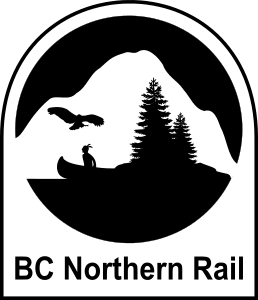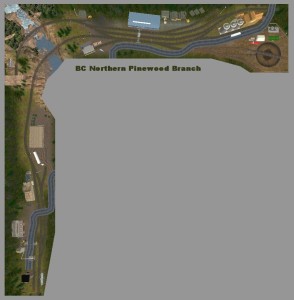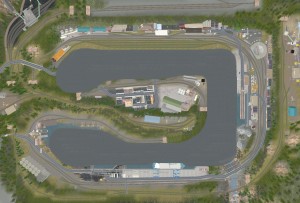
Hinweis: Die hier vorgestellte Hintergrundgeschichte der fiktiven Bahngesellschaft British Columbia Northern Railway (BC Northern Rail) ist Stand Oktober 2017 veraltet und wird überarbeitet. Speziell die Ortschaft Prince Rupert wird von der BC Northern nicht mehr auf der Schiene erreicht sondern auf dem Wasser (Eisenbahnfähre).
Es wird noch bis 2023 dauern bis alle Änderungen sorgfältig hinterlegt sind.
Neue Version: Die Geschichte der BC Northern Railway
BC Northern Rail
Die British Columbia Northern Railway ist eine Modelleisenbahn ohne konkretes Vorbild von Mirco Adam.
Die Gesellschaft hat ihren Sitz im nördlichen British Columbia in Kanada und dehnt sich von Prince Rupert kommend nach Norden aus. Dabei passiert die gedachte Trasse zunächst Gingolx und folgt parallel der Kincolith Rd. nach Greenville in das meandernde Flusstal des Nass River hinein. Hier verläuft die Trasse parallel zur Nass Rd. und im weiteren Verlauf dem nur in den Sommermonaten geöffneten Nishka Hwy.
In Höhe der Ortschaft New Aiyansh zweigt die Pinewood Branch ab, welche die BCNorthern Richtung Terrace führt, wo ein Interchange mit der Canadian National besteht. Neben Rosswood auf halbem Wege zwischen Mainline und Terrace finden sich dort die fiktiven Siedlungen Pinewood und Big Creek.
Die Steward Branch führt von Stewart (BC) bzw. Hyder (AK) nach Osten, bleibt dabei auf kanadischer Seite und führt dann parallel zum Highway 37A nach Meziadin Junction zur BCN Mainline. Diese verläuft parallel zum Highway 37 in Richtung der ehemals von der British Columbia Railway projektierten Dease Lake North Line (Takla Sub). Auf halber Strecke zwischen Iskut und Dease Lake erreicht die Strecke ihren Interchange Yard mit Anschluß an die CN bzw. im Sommer 2002 noch an die BC Rail (zur Erinnerung: Das modellierte Anfangsdatum der BCN ist der Sommer 2002 und die BC Rail wurde noch nicht von der CN geschluckt), deren Takla Subdivision im Süden kurz dem Stikine River folgt und dann Richtung Skeena River abdreht. Die Takla Sub folgt ab hier dem Highway 37 nach Dease Lake.
In der Realität endet die ausgebaute Trasse kurz hinter Chipmunk BC. Unsere fiktive BC Northern jedoch hat die Trassenrechte bis Dease Lake von der Provinz BC geleast und die Trasse nach Dease Lake fertiggestellt. Dort wäre ein Interchange mit einer fiktiven Bahnlinie möglich, die das kanadische Streckennetz an das der Alaska Railroad (AAR) anbindet.
Alle fiktiven Ortschaften und Industrien entlang der der BCN gehen davon aus, dass hier Rohstoffe in größerem Rahmen abgebau werden, wobei die Ergiebigkeit jedoch nicht ausreicht um einen Class 1 Carrier wie CN zu interessieren. Die BC Northern operiert wie eine Shortline mit schlanken Verwaltungsstrukturen und Kundennähe.
BC Northern Rail Map (veraltet!)

There is not much info left on that Dease Lake North Line (Takla Subdivision) project, but this post offers a lot of related info. Pictures may be found at the BCRail Flickr Group.
Meine BC Northern lehnt sich stark an der BC Rail an (British Columbia Railway heute Canadian National), gerade was die Farbgebung der heutigen Lokomotiven betrifft.
Schaut Euch ruhig einmal um und klickt Euch durch diese Webseiten, da diese zukünftig den einen oder anderen für Modelleisenbahner interessanten Artikel zu bieten hat: Gleise und Weichen im Selbstbau, Kitbashing und Selbstbau von Rollmaterial, Papier-/ Kartonmodellbau, 3D Drucken, sowie einen generell kostengünstigen Ansatz zum qualitativ hochwertigen Modellbahnvergnügen.
Hier ist ein Gleisplan der mit einem älteren PC Spiel erstellt wurde (Trainz Simulator 2004):
Die Abmessungen der Abbildung betragen 8,8 Meter auf 6,3 Meter, was hauptsächlich den notwendigen Tolleranzen des Spiels geschuldet ist. Die Abmessungen des Gleisplans in XTrkCAD betragen dagegen 6,9m auf 4,6m. Der Gleisplan ist auf „Mehrspieler-Modus“ ausgelegt, das heißt, wäre es eine real gebaute digitale Modellbahn, so könnten mehrere Züge simultan das Layout befahren.
Neben diversen Zügen die aus dem Schattenbahnhof nach Prince Rupert gefahren werden, gibt es auf der Anlage Arbeit für einen Yard Switcher in Prince Rupert (der auch die lokalen Industrien bedient), einen weiteren Barge Switcher in Prince Rupert und einen Switcher der den Containerhafen und den Getreidespeicher bedient. Diesen Job dürfte jedoch der Barge Switcher mit übernehmen. Je nach dem wie lang die Session sein soll.
Darüber hinaus geht von Prince Rupert ein Local richtung Norden (vom Classification Yard aus nach Links) zur Lake Morgan Timber Co., Lake Morgan Kaolin Co., Skeena Lumber und dem großen Big Creek Sägewerk bis zur Blue Hills Coal Mine, von wo aus die Strecke Richtung Dease Lake Route (Schattenbahnhof) weiter führt.
Ferner gibt es einen Local für die Pinewood Branch. Eine alte SD7 bedient die Branch bis zum Interchage Yard an der Blue Hills Mining Company. Dort befindet sich ein kleines Betriebswerk. Die SD7 bedient auch die Mine.
Die Namen sind alle fiktiv. Aktuell recherchiere ich jedoch die Geschichte der Portland Canal Short Line Railway (PCSLR) und der daraus entstandenen Canadian Northeastern Railway (CNER), sowie einiger anderer Strecken in der Umgebung. Damit könnten aus dem Blue Hills Bergwerk das Red Cliff Bergwerk werden. Und andere Namen auf basis der historischen Daten angepasst werden. Folgende Webseiten sind diesbezüglich interessant:
Lesser known and obscure railroads of Alaska
Canadian Rails, Ausgabe 442 (PDF, 7 MB)
BC Northern Railway
[engl. Originaltext der BC Northern Rail Webseite]
British Columbia Northern Railway is a freelanced model railroad by Mirco Adam.
It is virtually located in Northern British Columbia (CA) expanding from Prince Rupert northward via Stewart, paralleling Highway 37A to Meziadin Junction and then Highway 37 towards BC Rail’s formerly proposed Dease Lake North line (the Takla Subdivision).
BC Northern borrows a lot from BC Rail, especially the current paint scheme of it’s motive power.
Feel free to click through this site, as it might offer a few interesting themes for model railroaders: handlaying track and turnouts, kitbashing and scratchbuilding cars and locomotive parts, paper model building, 3D printing and a general least cost approach to high quality model railroading.
[engl. Originaltext: BCN Histroy]
Auch die folgende Abbildung wurde mit TRS2004 erstellt und zeigt die fiktive Pinewood Branch als Rangier Layout. Dieser Gleisplan orientiert sich trotz der Tolleranzen des Spiels stark an der XTrkCAD-Version und misst 3,9 Meter auf 3,9 Meter. Unter dem im Bild links gezeigten senkrechten Anlagenteil befindet sich ein Schattenbahnhof der 3 Züge bereitstellt und für zwei weitere (kurze) Züge die Möglichkeit zum Umsetzen der Loks bietet.
Das Layout bietet die Möglichkeit an beiden „Enden“ erweitert zu werden um zum Beispiel eine Rundstrecke zu ermöglichen.
 English Version
English Version
PLEASE NOTE: The background story of the fictitious railroad company British Columbia Northern Railway (BC Northern Rail) presented here is outdated as of October 2017 and is being revised. In particular, the BC Northern no longer reaches the town of Prince Rupert by rail but by water (rail ferry/barge).
It will take until 2023 for all changes to be carefully filed.
New Version of the fictional history of the railway: The BC Northern Rail Story (EN)
Introduction
The time is Summer 2002. BC Rail is still there and the northern coastal region of British Columbia is slightly more populated and industrialized than in the real world.
A canadian shortline serves as a bridge line between Dease Lake BC and Chipmunk BC at the northern terminus on the BC Rail Takla Subdivision and Prince Rupert and Terrace, at the western and southern terminus of the CN Skeena Subdivision (respectively).
Main commodities hauled are coal, kaolin, forest products, ocean foods, grain and metal ore.
Dating back to April 1914 BC Northern Rail is a Class 2 regional carrier.
British Columbia Northern Ry.

Historical Overview (Timeline)
1910 – First standard gauge Railroad Tracks laid in Stewart, BC, Canada. Construction began in June by the Portland Canal Short Line Railway (PCSLR), whose operating right granted the right to build a railway from Stewart/Hyder inward across Bear Creek Pass. It served various mines along its 21km right of way. The roster consisted of two identical Pittsburgh Works 2-6-0 steam locomotives built in 1891. Cars were predominantly wooden box and flat cars. A single combine provided for passenger transport. There was no turntable or wye. Both locomotives operated with the front pointing away from the coast. At Steward an immense wharf had to be build to get the railcars across the tidal flats of Stewart Bay to the deep water area of the Portland Canal, where the steamers of both the Pacific and the Union Steamship Company usually moored. Several plans were made, to make Stewart the western terminus of a potential fourth transcontinental railway in Canada. And survey of the right of way was completed up the Bear River Pass to Meziadin Lake though the trackwork didn’t extend beyond Red Cliff in October 1911.TThe projected route included a more than 650m long tunnel u der the pass and skirted the lake around its northeastern shore. Fro. There plans were drawn to swing south toward Hazelton (Terrace), where there was the Grand Trunk Üacific line.
The railway however – by then – sported a new name, the Canadian Northeastern Railway (CNER). It operated until 1915. By the. In reality the railroad discontinued any plans to expand their network furthet east. In the alternate History of my BC Northern Railway, this marked the turning point. Contrary to the survey information that the Groundhog Mountains coal deposits were said to be warped and inaccessible from an economical point of view, this coal field proved to be as rich as Mann, the Railway Chief Executive Officer, had envisioned.
1912 – The BC Northern’s first 3ft narrow gauge line opens between Meziadin Lake, BC and three logging camps in the area. It was projected to interchange with the PCSLR/CNER. In 1930, the BC Northern aquired the CNER to merge the two railways. Standard gauge track was laid up to Meziadin Lake where there was a dual gauge interchage yard with the BCNR. This became Meziadin Junction. When the motherlode of the Red Cliff mine was found in october 1914, traffic increased dramatically.
1917 – Two Copper ore mines opened, existing 3ft mainline upgraded to standard gauge. Logging branches still used 3ft gauge. Trains were transloaded at various sidings of the mainline.
1920 – Dunwell Mine located at Bitter Creek opens
1920 – Coal mine opens near Meziadin Junction. Workforce requirements and increasing freight volumes boost population in the area.
1923 – Blue Hills Coal Mine opened near Alice Arm. Mainline extended south to haul coal frome this mine to the port of Steward. The old tracks to Meziadin Jct. were now officially called Northern Division, while the line south was then known as the Stewart Division.
1929 – Consolidated Mining and Smelter acquired the charter and did some work on the line, the world depression cancelled their plans.
1930 – Logging Camps, a Paper Mill and a Coal mine open near Mill Bay. BCN mainline further extended south to get the comodities to the sea. The two legs of the Stward Division were named Portland Subdivision (from Stewart South to Alice Arm) and the Alice Arm Subdivision (from it’s namesake town to Mill Bay.
1934 – Board of directors discuss a connection to Prince Rupert via Port Simpson. The plan is rejected due to the financial strain.
1940 – Northern Division extended via Meziadin Jct. to Thunder Ridge (a freelanced location name), where a big ore mine hase opened (this extension was known as the Thunder Ridge Subdivision).
1952 – Port Adams, a barge slip and ferry pier outside Mill Bay inaugurates Barge Service to Prince Rupert (to interchange railcars with CNR). Company housing is provided at the site.
1955 – BCN extends the Stewart Division west toward Canyon City, where numerous logging sites were located (a part of the line
1967 – BC Northern finally connects its mainline to Port Simpson and Prince Rupert to interchange with the Canadian National Railway.
1970 – Port Adams now operates Barges to Alaska. The village of Mill Bay is now part of the town of Port Adams.
1978 – The year after BC Rail stopped contruction of the line to Dease Lake somewhere near Jackson, BCN finally finished construction of the last leg of it’s Northern Division to Chipmunk, BC, where a small interchange yard (at the BC Rail site) is located.
1990 – After finanvial crisis competitor CN aquired about half of the stocks dealed at canadian stock exchange markets and was technically in control of the railroad since then. The operation continued as a joint venture between BCNorthern Holding and CN, leading to a variety of rolling stock. locomotives sporting CN paint schemes with BCN sublettering joined BCNs fleet of locomotives in an Ontario Northland similar paint scheme.



